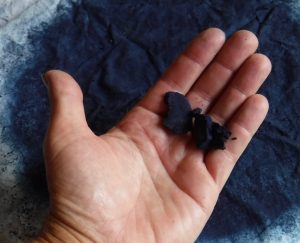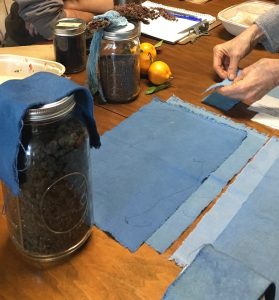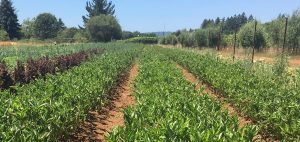This will be my fifth year growing Japanese indigo, Persicaria tinctoria, in Sonoma County, California and surrounding areas.
My introduction and inspiration to grow indigo came from Rebecca Burgess, founder of Fibershed, back in 2013, while attending a presentation at the Jimtown General Store in Geyserville, California, where she was promoting her first book, Harvesting Color,and giving away indigo seedlings.
Who would have guessed only a couple years later I would be growing thousands of indigo plants at multiple farms, giving a presentation with Rebecca and giving away seedlings I had grown?
When Blue is Green is an account of my recent history growing, processing and dyeing with naturally grown indigo.
Blue is Green when indigo is grown and processed naturally and responsibly.
Our indigo was grown on farms using organic and biodynamic farming practices.
Blue is Green when indigo is available as an alternative to chemistry based blue dye stuffs. The production of synthetic indigo has a petroleum base and results in a toxic waste stream.
Blue is Green when all the beneficial wellness properties of blue are appreciated and used as needed. Parts of the Indigo plant have special qualities such as anti-bacterial, anti-fungal, and are used to treat skin conditions, including eczema.

Indigo pigment
Blue is Green at Fiber Circle Studio in Cotati, California, a wonderful new fiber arts makers space and home to a ‘community’ indigo dye bath made from our locally grown indigo. Alisha Reyes, owner of Fiber Circle Studio, and I have maintained a community indigo dye vat for the last six months while also presenting a series of workshops. Skeins of yarn have been dyed to knit and weave projects by local artisans.

Fibershed Indigo work in progress
Blue is Green when our locally grown indigo is used to dye cones of cotton yarns to supply our regional mill to create yardage of denim. We are currently researching the methods to determine ‘best practices’ for dyeing at this scale.
Blue is Green when indigo is a viable alternative crop for local farmers along with other dye crops. Every year we get more requests for indigo seedlings. This helps secure a healthy seed supply also.
This year I am growing over 5000 indigo plants. 3500 have been planted at the Santa Rosa Junior College, Shone Farm in Forestville, California.

Shone Farm indigo field
Open Field Farm in Petaluma, California, is growing over 1000 plants for their third year in a row. Indigo seedlings were delivered to school gardens and other farms in our local region
The harvested indigo leaves can be used to make the indigo blue dye using various methods, including fresh leaf dye baths, pigment extraction, and drying the leaves to be composted. I have used and continue to explore all these methods.
********************************
Visit fibershed.com and www.fibercirclestudio.com to learn more about our local indigo community, upcoming presentations, demonstrations, workshops, indigo seeds and seedlings. Craig Wilkinson has grown and processed Japanese indigo in Sonoma County for the past five years and can be contacted at craigsIndigo@gmail.com.
Click here for the next article